|
Hello there,
Here is the final part of a personal reminiscence and quick look by one Australian expat living in New Guinea, pre Independence. I had a total of sixteen years flying in PNG. The years 1966 to 1975 were by far the best and most satisfying.
After 1975, some of us went on to fly bigger and better aircraft (and some on to much bigger and better aircraft), though our pilot friends who crashed up there never had that opportunity. Just about all the old timers say that the period prior to Independence was “the best of times”.
The law and order problem, far from perfect even then, was certainly like heaven compared to today’s total lawlessness, violence and corruption. Ray Whitrod, Commissioner of Police in PNG (1969-1970), once responded to law and order problems in Mt Hagen by saying, “Give me ten good men and I’ll clean the place up”. Today the saying would have to be, “Give me ten thousand good men”.
I will avoid too much discussion on politics about PNG, and if Independence was granted too soon. The younger generation in PNG thinks not, the old time natives really know what they lost*. The younger ones are swayed by UN propaganda, political correctness and modern notions (inculcated) of bad old colonial days. Often academic spin completely takes away the reality of good deeds done and injects racism as the root cause of everything. Those authors (academics and newspaper journalists) are liars; for this is insane, a fabrication for political reasons and completely wrong.
I lived in Lae for five years 1968-1973. It was a beautiful spot: manicured lawns everywhere, white painted rocks beside the roads, immaculate botanical gardens, tranquillity. Everything was serviceable. The only crime was thievery. Since 1975, the place has become increasingly filthy, covered in red betel juice (buai) spittle. The roads are in such a cratered state, a modern armoured tank would disappear down them. There seems to be no money being spent on anything. Crime is rampant and now includes frequent violence and murder.
Suffice to say that the ordinary native people were a lot better off in those pre-1975 days, when somebody really cared: the Australian Administration of TPNG. Kiaps did a fantastic job and always had projects on the go: building roads, schools, airstrips and infrastructure, all of which benefited the local bush people. Where is the money from huge gas, gold, copper and timber projects going today? The bushies see none of it. Worst of all, without funding, many airstrips ran down and closed (as Omkalai, Keglsugl and hundreds of others that no longer exist).
TPNG aviators lost many close friends in aircraft accidents and personally had more than their share of extremely dangerous and terrifying flying situations. “If I get out of this, I will quit flying.” They were back again tomorrow.
It was then a great lifestyle. Goroka in 1966 was a young man’s paradise. Plenty of Aussie and NZ girls working there, mostly good, some bad, plenty of flying and a wonderful social life. The beer and wine did flow. There was much fornication.
Young men could make the error of relying on native servants too much (then called haus-bois) or being too trusting. Being too lazy to do one’s own cooking often lead to dysentery, letting them do your washing was fraught with hazard. Too much Rinso in one’s underpants caused serious burning long daunbilo (down below). It was wise to iron your own good shirts. I once went to put on a uniform white shirt and was not amused to find the back completely burnt out in the perfect outline of an iron. Asking my servant what had happened here, he answered, “Bikpela rat emi kaikai dispela” (a large rat had eaten it). When socialising, a Canadian pilot friend said to me, “I hate to tell you, Graham, but this whiskey of yours tastes very much like 100% cold tea”. I wonder where my large and expensive Bowie knife is now? Most of these haus bois knew exactly when to quit and vanish.
For those, scratching their heads at certain unfamiliar phrases and descriptions, the following should be useful.
Lae Veranda, Air Traffic Control. Before the real, standard control tower was built at Lae airport (in the City by the sea, not Nadzab), the ATC lads worked their separation and control duties from a small room that was attached to the original Dept of Civil Aviation building on the original Lae airport. This edifice, about as big as an average bathroom, was actually higher than the adjoining DCA Briefing Office by all of five feet. The entrance to the ATC room was via the Briefing Office. If you wished to visit Lae veranda, you needed to climb three steps to the door. The ATC boss was Phil Graham, a pipe smoker and very stuffy, but most clever and he enjoyed a drink of whiskey after work: he was a WW2 RAF bomber pilot.Ex-RAN Dean Darcy was the star controller. He looked like Lou Costello and had an amazing sense of humour. With many aircraft flying in the vicinity, Dean kept up a continuous commentary, half for the pilots and half (with expletives not transmitted), for humour. He would call certain pilots by insulting and rude names, often reflecting their brain power, general usefulness and other amusing observations, and then press the transmit button for the ATC instructions that the pilot heard. He would have been in serious strife, had he lacked coordination or became confused and pressed the TX button when seriously insulting someone.
Some pilot characters used to try the patience of the experienced briefing officers. One aviator from Crowley Airways used to walk in (having seen his most varied roster) and put in a single flight plan with four different aircraft types and aircraft registrations on the one page. The senior briefing officer, Alan O’Conner , would say “you cannot do this, Dudley”, (Dudley Hardy). Dudley would casually say, “that’s what I am doing, what you see is what you get”. He was never denied an airways clearance to work as his roster directed. “Laughing Dudley” was casual, but he was a good bush pilot.
Kiap. The Australian Administration of the Territory of Papua and New Guinea was from 1920 to 1975. The word Kiap is pidgin and evolved from the German word Kapitan, (Captain). Essentially, they were area administrators and patrol officers. Young men were trained in various aspects of administration, law, history of TPNG and other duties. As they were often alone in a remote outpost, representing Australia, they were young men with very wide ranging duties and responsibilities. The last area to be considered “controlled” (patrolled) was in 1963. Many areas had cannibalism, pay back killings, no laws, endless tribal wars about land, women and pigs. The last area where Australian Kiaps found a tribe that had never seen white men was in the 1960s.
They did a fantastic job.
Pidgin. Rather than outline every word and meaning, you can Google it, it is all there.
Cheers,
Graham
*In 1993,I was in the Cloudlands Hotel, Tabubil. This was shortly after Jasper Maskelyne and I introduced the Dash 8 to the Ok Tedi Mine. We were meeting many people in this happy time, beside the bar. An old (Lapun) New Guinea man, not dressed in modern clothes, came up me. He had no English, but had heard that we were old TPNG men “bilong taim bipor” (from the time before Independence). He approached, with tears in his eyes, held my arms tightly and said “Tenkyu tumas, mi amamas long lukautim yupela. Nu Gini nau em i bagarapim olgera. Mi laik lukim ol Australia na Kiap i kamap long lukautim mipela””. (Thank you, I am happy to see you. New Guinea is now destroyed. I would like to see Australians and Kiaps come back to help look after us”. GCS.
Click on a thumbnail photo to see the full size version.
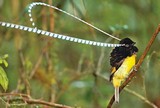 |
|
King of Saxony Bird of Paradise, New Guinea. “Fly away, beautiful bird and find a dense and remote rainforest to hide in. Many men will hunt you for your feathers and finery”. |
 |
|
A native village on a ridge near Mount Elimbari and Chuave. Chimbu Province, 1966. |
 |
|
Finals to Lae, 1967. When Lae veranda was the tower. The Control Veranda is to the left of the far end 1000 foot markers. This view is from Macair’s Cessna 336 push-pull. Sypho returning from Pindiu, yet again. |
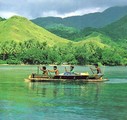 |
|
Villagers from Normanby Island near Milne Bay. |
 |
|
Omkalai airstrip, near Chimbu. A really steep airstrip, with a 13.3% slope. |
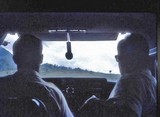 |
|
GCS and John Crowther, Talair C/206, 1966, landing at Omkalai. |
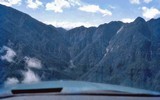 |
|
Asaloka Gap from the Ramu River side (Madang side), 1966. Goroka is behind the mountain on the left. |
 |
|
On Finals at Porgera, Western Highlands, 1966. No go-around for aircraft here. That was proven by the RAAF. Ten percent slope on the strip and 7200 feet above sea level.
Porgera was always all about gold. Initially it was underground mining and much later it was open pit-mining. Today the Porgera Gold Mine is in the world’s top ten of producing gold mines. |
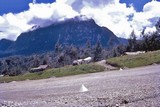 |
|
The old Porgera airstrip with a Caribou fuselage. The country’s most expensive boi haus. The civilian aviation rules on requiring new pilots to be checked five times over a route was frowned on by the military.
During times of war, they said, the RAAF have to be able to fly anywhere in any country. Without having seen it before. So be it. Caribou crashes here, in the Kudjeru/Bulldog valley and at Tapini attest their SOP is more dangerous.
Had a check pilot been aboard this aircraft, he could have told them they were at the wrong aerodrome (this was not Laiagam, their destination: that airport was over 20 nautical miles away) and Porgera was closed due works in progress.
The crew was on close finals when they saw scores of native labourers, standing chest deep in a number of drainage ditches, shovelling away. Not wishing to land on the crowd, they attempted a go-around.
Photo: Ross Shepherd. |
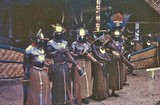 |
|
Wapenamunda lads await their turn to display. Mt Hagen Show, 1968. |
 |
|
Keglsugl airstrip, Chimbu Province, 1966. 8130 feet above sea level. Mount Wilhelm is in the background.
The Senior Father at the nearby Catholic Mission was a German. He enjoyed a considerable amount of beer with every meal. As a pilot, invited for lunch and yet to fly back to base, one could only drool in envy. Photo: Garry Honour. |
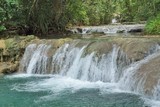 |
|
Butaweng Falls and pool, near Finschhafen. There is a story that during WW2, a 250 lb bomb was used by the Americans to make a deeper diving and swimming pool.
This is probably apocryphal as no amount of research or asking old time TPNG people can confirm this. There were thousands of American servicemen and women here. It is close to the hospital and USN wharf areas.
I was told this “fact” by a fellow known unkindly as “Bullshit Bert”, so who knows. Bert was a WW2 Australian soldier and I respected him. It is quite a deep pool. |
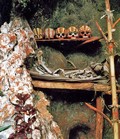 |
|
Huli Ancestor Cave, Tari. |
 |
|
Typical highland flying weather. The Finnisterre Ranges near Wantoat. Naturally, one needs to fly twenty miles more to the destination behind the centre mountains.
|
 |
|
Time to go home. Let’s turn the aeroplane around. |
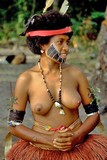 |
|
A young woman from the Trobriand Islands. |
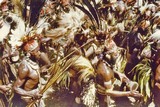 |
|
Warriors at the Mt Hagen Show, 1968. If you ever doubted their physical fitness, a walk with these fellows in the Highlands and up a mountain would soon convince you that they were really fit.
And that you were not. |
 |
|
Pindiu airstrip, Morobe Province, 1967. I flew there so many times in that year that I got frustrated. As I taxied out, Dean Darcy, the Air Traffic Controller in Lae veranda, said to me “Graham, Pindiu again? That’s only five times today”.
Sypho: “Don’t rub it in Dean”. I knew every inch of the Mongi River to the coast, at low level, which was handy in foul weather. |
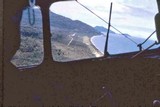 |
|
Kieta airfield, when it was grass. Captain Ray Baker and FO John Rutter, GCS in the jumpseat. Just arrived from Munda and Honiara, BSIP, 1968. |
 |
|
Misima, from Alby Munt's veranda, ca. 1971.
|
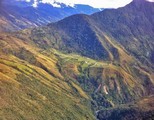 |
|
Tapini airstrip, Central Province, 1972. |
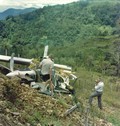 |
|
Macair’s Pilatus Porter, VH-PNH, crashes at Kanabea in March 1974. Chief Engineer Jim Mitchell with Insurance man Bill Cavanaugh. One fatality here.
Strong winds only occur for a few weeks every year in New Guinea. When they do, they create dangerous downdraughts on the lee side of high ridges. And some serious navigational errors.
Around 1968, a Cessna 402 pilot was tasked with a morning VIP charter from Goroka to Telefomin, in the Hindenburg Ranges, near the West Irian border. He made out his plan the night before (nil wind) and presented it in the morning.
He did not look too closely at his Notams, weather and especially the forecast and reported winds. Telefomin had no navigational aids.
He flew at 16,000 feet, on oxygen to stay above the 8/8ths cloud. He never saw the terrain below from abeam Mt Hagen. He used DR to get to Telefomin: nil wind dead reckoning. Had he looked at the weather, as presented by Goroka Tower, he would have realised that the upper winds were from the west at 70 knots. So when he thought he was at Telefomin, he was seriously short of the mark.
He then held for one hour (north/south patterns), waiting for the expected improvement. A missionary pilot advised him that Telefomin appeared open from the north. The great navigator then headed north, looking for a hole.
He came to the edge of the cloud and was astounded to see his home base of Madang far below. He was 250 nautical miles from where he had DR’d himself to hopefully be. Calling the Madang Tower would have been hard. |
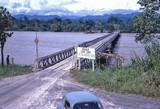 |
|
The WW2 Markham Bridge near Nadzab. |
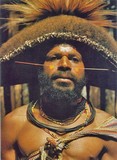 |
|
A Huli Warrior, from west of Tari. |
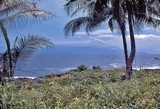 |
|
Kar Kar Island, 1968. Viewed from the Plantation Hotel, just north of Madang. A beautiful spot. |
 |
|
Kieta, Bougainville Island, 1971. When ordering breakfast at the Hotel here, it was “Eggs an tost or Toss n egg”. The PNG waiter was trying out his few words of English. That’s what it sounded like.
Pidgin for egg is kiau. I would have understood him much better in pidgin.
Normally, you would look at a printed menu and then order by numbers. “Mi laik namba tupela”. (I’d like to have No. 2.) |
 |
|
Rabaul with a localised shower. The old German Colonial Capital, this historic place sits beside Simpson Harbour. Mount Tavurvur volcano is closely aligned with the aerodrome’s runway.
HQ of Japanese Admiral Yamamoto during WW2 and scene of continuous very heavy aerial bombing, the greatest devastation has been caused by the surrounding volcanos that have periodically erupted violently. |
 |
|
Kabwum airstrip, 1971. A very busy place at one time. |
 |
|
Goroka, from the look-out, 1970. |
 |
|
Garaina airfield and the Tea Plantation in 1969, situated in the Waria Valley, Morobe Province. Angus Hutton started planting tea here in the early 1960s and by 1963 Garaina Tea was being sold in Australia.
As Angus and his father learned the tea trade in India, the plantation here was a model of efficiency. He even made the factory self sufficient on electricity by building a small hydro electric generator on the Bu Bu river. This harnessed the fast flowing stream which started high in the Chapman Range. There are no roads in and out of Garaina. The Waria valley was very wide and the tea was grown at about 2000 feet above sea level. |
 |
|
Tea Collectors. Local women learn a new trade, Garaina, PNG. Angus Hutton pioneered tea growing in New Guinea and his product was the best. He was the manager here.
In 1969, I did several charters from here to Tulley in Queensland, fully loaded with bagged tea seed, for a new plantation. After PNG’s Independence, some brilliant government team told Angus his services were no longer required.
He was “retired” in 1978 and returned to Australia. The tea plantation quickly fell into disrepair and has been closed down for many years. Talk about stupid decisions! |
 |
|
Macair Beech Baron, Rob Huntington flying. In May 1970, Macair was tasked to quickly move a great load of special tea fertilizer into Garaina. With no seats and chock full of fertilizer bags, these shuttles went on for a couple of weeks with four Beech Barons.
It was an excuse to practice up on our formation flying. Darcy, in the ATC veranda tower, insisted we take off separately but cleared us to proceed “in company”. This meant we were in formation inside ten miles. The first arrival at Garaina was thrilling.
Dot Feet, Loopy and Sypho flew low (200 feet above the roof) at 180 knots in V formation over Angus’ house and he was beside himself with joy. He drove quickly to the aerodrome and greeted us with “I haven’t seen anything like that since the War” |
 |
|
Some Macair types in 1973. GCS, Ray Feltman, Peter Black and Norm Graef, at Port Moresby, Jacksons Airport, after formation flying at an Air Pageant. |
Continued in Part 3.
|


































